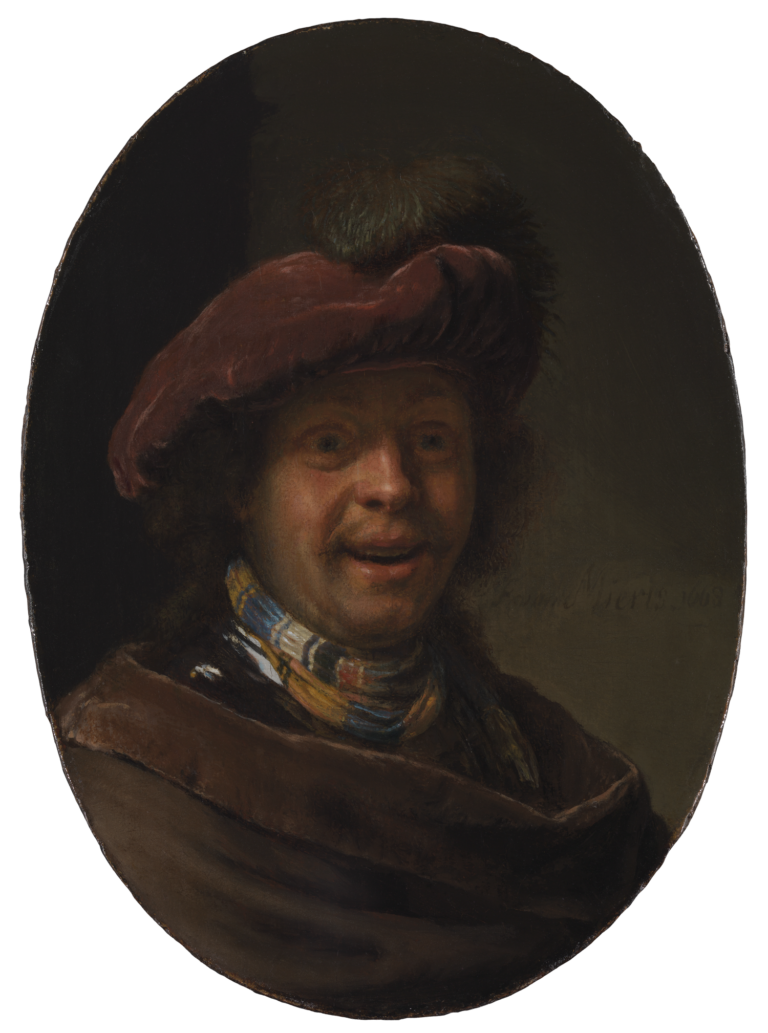Frans van Mieris the Elder produced numerous self-portraits and used himself as a model in many of his genre scenes.1 In no less than a quarter of his painted oeuvre, which numbers some 120 paintings, we encounter the faces of Van Mieris and his wife, Cunera van der Cock. In some cases, Van Mieris created a hybrid form, as in pendants from 1662 in which the artist depicted himself holding a pipe and his wife pulling the ear of a little dog.2 In this little painting, dated 1668, we can recognize the painter’s features and his double chin, as well as his characteristic moustache and curly hair.3 Situated before a plain background, Van Mieris painted himself bust-length with a smile on his face, as though surprised at seeing the viewer. Wound around his neck and partly draped over his shoulder is a patterned scarf that largely covers a shiny metal gorget, which contemporary viewers would have understood as having a military function.4 On the painter’s cap is a plume that is the same color as his brown hair. It is possible that Van Mieris, as he often did, originally paired this portrait with one of his wife; the earliest of such pendants date around 1657–58.5 He usually painted such pendant portraits on oval panels of approximately the same size as the portrait discussed here, as in pendants dated 1661 (fig 1) and (fig 2).6
The fact that Van Mieris produced such an unusually large number of self-portraits is no doubt directly associated with his fame. This artist probably turned to the mirror for artistic purposes more frequently than any other artist in the Republic, including his teacher, Gerrit Dou (1613–75), and Rembrandt van Rijn (1606–69), both of whom also came from Leiden.7 In his youth, Rembrandt had produced a series of etchings that arose from intense observations of his own physiognomy and the constant changes in his facial expression. These are essentially studies of “affects” or passions, what we would call emotions. This tradition cannot be separated from certain passages in art-theoretical writings. Rembrandt’s pupil Samuel van Hoogstraten wrote about the subject in his Inleyding tot de hooge schoole der schilderkonst (Introduction to the Advanced School of Painting), advising artists who studied themselves in the mirror “to transform themselves into actors,” and that in acting out the “passions” they should endeavor “to be player and spectator at the same time.”8
Van Mieris conceived this small painting as a tronie, a type of picture in which painters represented a character type or a particular facial expression, in this case, surprise. In traditional portraits, sitters were never depicted smiling.9 Moreover, in his “official” self-portraits, Van Mieris always presented himself as a true gentleman, as can be inferred from a painting of 1667 (fig 3).10 This type of small “pseudo” self-portrait was probably intended as a comic image, which at the same time constituted a fine example of Van Mieris’s exquisite technique. That paintings of this kind were not interpreted as “ordinary” portraits is clear from descriptions in the inventory of the Leiden collector Franciscus de le Boë Sylvius (see FM-104). This document made a clear distinction between the portraits and tronies of Van Mieris in the collection, even though the painter and his wife were recognized in each.11
